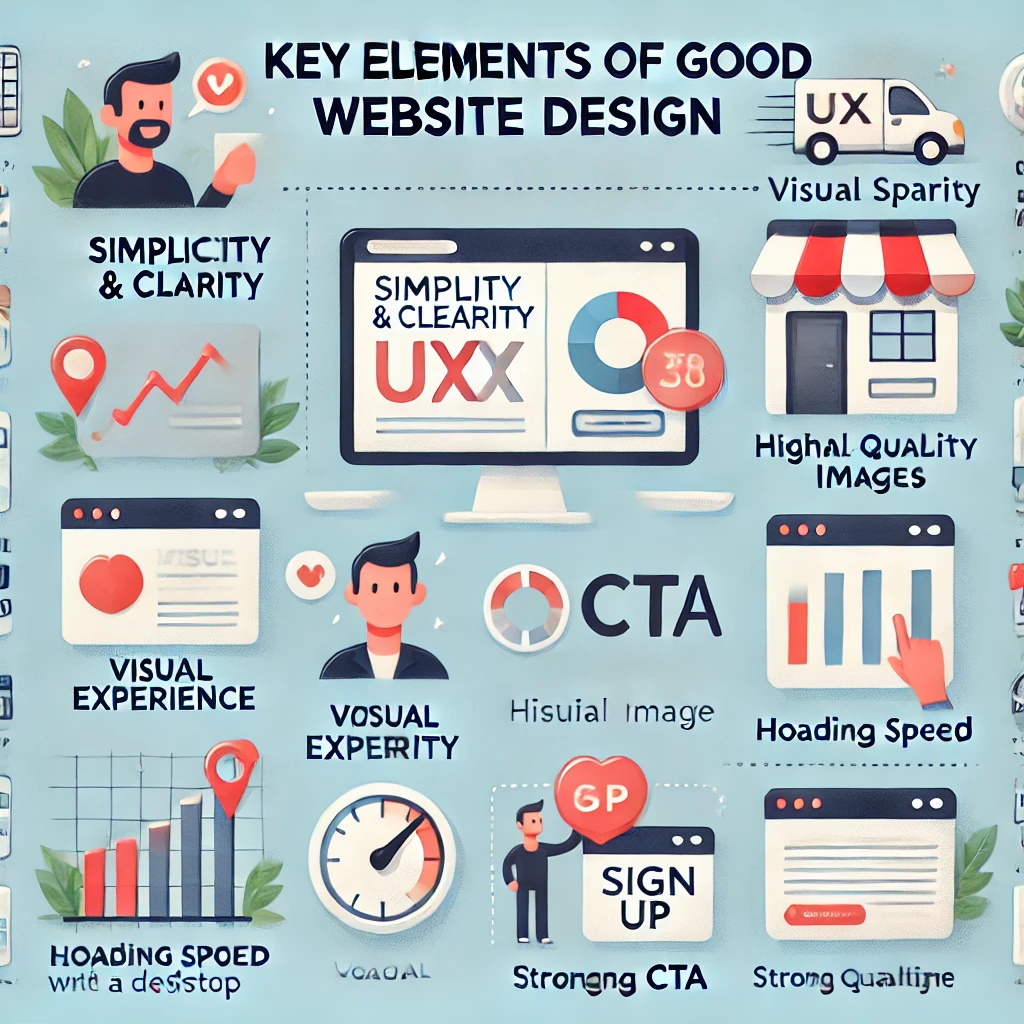A well-designed website can be one of the most powerful tools for attracting visitors, engaging them, and converting them into loyal customers. However, good website design is more than just aesthetics. It’s about creating a user-friendly experience that guides visitors through your site seamlessly while achieving your business goals. In this guide, we’ll explore the key elements of good website design and how to incorporate them into your site.
Simplicity and clarity in design
One of the hallmarks of good website design is simplicity. A clean, uncluttered layout allows visitors to find what they’re looking for quickly. Overloading your website with too much content, flashy graphics, or complicated navigation can confuse users and drive them away.
Stick to a minimalistic design approach, using clear fonts, well-spaced elements, and intuitive navigation menus. White space, or the empty space between design elements, is also important as it improves readability and draws attention to key parts of the page.
Why clarity is essential
Visitors to your website should be able to understand your message and navigate through the site easily within seconds. If they can’t, they’re likely to leave and go elsewhere. Avoid jargon, use concise text, and ensure that your call-to-action (CTA) buttons are clearly visible and easy to find.
User experience (UX) and navigation
User experience (UX) is about how a visitor interacts with your website. A good user experience leads to longer site visits, higher conversion rates, and a more satisfied audience. The key to great UX design is making your website easy to navigate, intuitive, and responsive to user needs.
Clear and consistent navigation is critical to keeping visitors engaged. If users can’t find what they’re looking for within a few clicks, they’re more likely to leave. Use easy-to-understand menu labels and organize content in a logical manner, with essential pages like “About,” “Products/Services,” and “Contact” easily accessible.
Responsive design
With more people browsing on mobile devices than ever before, a responsive design—one that adjusts seamlessly across different screen sizes—is a must. Good website design ensures that your site looks and functions well on desktops, tablets, and smartphones. Not only does this improve user experience, but it also helps with search engine optimization (SEO), as Google prioritizes mobile-friendly sites.
Visual hierarchy and content structure
Visual hierarchy refers to the arrangement of elements on a page in order of importance. It guides the user’s eyes to the most critical parts of the page, like headings, CTAs, or key information. By using visual cues such as larger fonts, bold colors, or strategically placed images, you can direct attention to what matters most.
At the same time, content structure should be logical and easy to follow. Break up large blocks of text with subheadings (like H2s and H3s), bullet points, or visuals to improve readability. This makes your content more digestible and keeps users engaged for longer periods.
The role of typography
Good typography goes hand-in-hand with content structure. Choose fonts that are easy to read, and use consistent styles throughout the website. Hierarchy in text (headings, subheadings, body text) helps visitors understand the flow of content and gives them visual breaks as they scroll through your page.
Fast loading speeds
Nothing drives visitors away faster than a slow-loading website. Users expect pages to load in two seconds or less, and if your site takes too long, you’ll lose potential customers. Moreover, page speed is a ranking factor for search engines, meaning slow websites are penalized in search results.
Optimize images, minimize large scripts, and use caching to improve your site’s loading time. Regular performance checks and using tools like Google PageSpeed Insights can help identify areas for improvement. A fast website ensures that users stay longer, increasing your chances of conversion.
High-quality visuals and images
Visuals are a powerful way to communicate your brand message and capture the attention of your audience. Good website design uses high-quality images, videos, and graphics to enhance the overall aesthetic of the site without overwhelming it. Avoid using low-resolution or generic stock images, as they can make your website look unprofessional.
Images should be relevant to your content and strategically placed to support your message. For example, if you run an e-commerce site, ensure that product images are high-resolution and provide users with multiple views to help them make purchasing decisions.
Alt text for images
Including alt text (alternative text) for images is not only good for SEO but also makes your website more accessible to people using screen readers. Alt text should describe the content of the image clearly, providing additional context for users and helping search engines understand the image’s purpose.
Consistent branding
Your website is often the first interaction potential customers have with your brand, so consistency is key. A good website design reflects your brand’s identity through its color scheme, logo, fonts, and overall style. This helps build trust and ensures that visitors remember your brand.
Keep your branding consistent across all pages of your website, as well as across other marketing channels (like social media and email campaigns). Consistency in branding reinforces your message and strengthens your online presence.
Strong call-to-action (CTA)
Every website should have a clear goal, whether it’s driving sales, capturing leads, or encouraging users to sign up for a newsletter. A well-placed and compelling call-to-action (CTA) guides users towards that goal. Examples of CTAs include “Buy Now,” “Sign Up,” or “Contact Us.”
Effective CTAs are easy to find, use action-oriented language, and stand out visually on the page. Ensure your CTA buttons are large enough, contrast with the background, and are strategically placed throughout your site where users are most likely to take action.
Conclusion
Good website design goes beyond aesthetics—it’s about creating a seamless, enjoyable experience for users while achieving your business goals. From simplicity and navigation to responsive design and fast loading times, each element plays a crucial role in your site’s success. By following these best practices, you’ll be able to create a website that not only looks great but performs well in terms of user engagement and conversion.
Frequently asked questions (FAQ)
What makes a good website design?
A good website design is visually appealing, easy to navigate, and optimized for a seamless user experience. It should have clear and concise content, fast loading speeds, mobile responsiveness, and strong calls-to-action (CTAs) that encourage users to take specific actions.
How important is mobile responsiveness in website design?
Mobile responsiveness is crucial in today’s digital landscape. With more users browsing on mobile devices, your website must adapt to different screen sizes and still offer a great user experience. Additionally, search engines like Google prioritize mobile-friendly websites in their rankings, making responsiveness important for SEO.
What role does navigation play in good website design?
Clear and intuitive navigation is key to a positive user experience. Visitors should be able to find the information they need quickly, without confusion. Organized menus, simple navigation bars, and a logical flow of content keep users engaged and prevent frustration.
Why is website loading speed important?
Fast loading speed is essential because users expect websites to load quickly—ideally in two seconds or less. Slow websites lead to higher bounce rates, meaning users leave before the page fully loads. Page speed also impacts SEO rankings, as search engines favor faster websites.
How do visuals impact website design?
High-quality visuals and images can enhance your website design by making it more engaging and professional. However, visuals should be used strategically and should support the content without overwhelming the user. Ensure images are optimized to avoid slowing down your site.
What is the importance of a strong call-to-action (CTA)?
A strong CTA is essential for guiding users toward your desired action, such as making a purchase, signing up for a newsletter, or contacting you. Effective CTAs are clear, visible, and encourage users to take immediate action, helping to improve conversion rates.


